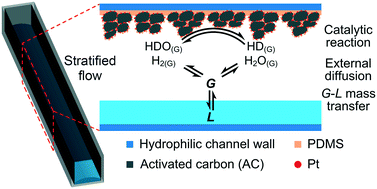Catalytic exchange of hydrogen isotopes intensified by two-phase stratified flow in wettability designable microchannels†
Abstract
This work develops a reliable method to achieve stratified flow in squared cross-section microchannels by endowing the four channel walls with very different wettabilities. The gas–liquid flows are studied experimentally in six kinds of microchannels with different wetting partitions on the channel walls, where occurrence of the stratified flow is found to strongly depend on the wetting partition and the individual flow rate of gas or liquid. Among them, the microchannel possessing three hydrophobic and one hydrophilic walls (3S1H) shows great potential in facilitating liquid phase catalytic exchange (LPCE) of hydrogen isotopes. Subsequently, a 3S1H microchannel reactor coated with hydrophobic Pt/activated carbon/polydimethylsiloxane (Pt/AC/PDMS) is fabricated to perform the LPCE at 30–80 °C and in a wide range of flow rates of hydrogen and water. The experimental outcomes not only unveil the relationship of the isotopic exchange performance with the temperature and flow pattern but also exhibit an outstanding isotopic exchange performance under the stratified flow.



 Please wait while we load your content...
Please wait while we load your content...